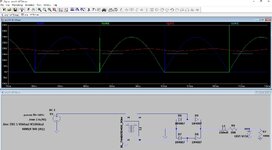neazoi
Advanced Member level 6
I have been experimenting with HV PSUs and I found that in a classic transformer - bridge rectifier PSU, one can remove the electrolytic filter capacitors if he includes a relatively large inductor after the bridge.
Here is my LTspice simulation, with the cyan line to represent the DC output.
I believe the inductor stores energy during the positive peaks and releases it during the low or zero voltage, thus providing the same action as that of a capacitor.
Is that the case or am I missing something?
If so, I wonder why companies like Tektronix and HP didn't use this simple technique and relied instead in electrolytics wich have EOL?
Here is my LTspice simulation, with the cyan line to represent the DC output.
I believe the inductor stores energy during the positive peaks and releases it during the low or zero voltage, thus providing the same action as that of a capacitor.
Is that the case or am I missing something?
If so, I wonder why companies like Tektronix and HP didn't use this simple technique and relied instead in electrolytics wich have EOL?
